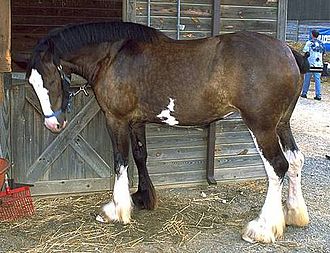Difference between revisions of "AY Honors/Clydesdale/es"
(Created page with "Adventist Youth Honors Answer Book/Clydesdale") |
(Created page with "Breed id/es | name = Clydesdale | image = clydesdale horse.jpg | image2 =Clydesdale horse.JPG | description = El '''Clydesdale''' es una raza de caballo de tiro derivado de lo...") |
||
| Line 3: | Line 3: | ||
{{ | {{ | ||
| − | Breed id | + | Breed id/es |
| name = Clydesdale | | name = Clydesdale | ||
| image = clydesdale horse.jpg | | image = clydesdale horse.jpg | ||
| image2 =Clydesdale horse.JPG | | image2 =Clydesdale horse.JPG | ||
| description = | | description = | ||
| − | + | El '''Clydesdale''' es una raza de caballo de tiro derivado de los caballos de granja muy trabajador de Clydesdale, Escocia, y el nombre de esa región. Se pensaba que tenía más de 300 años, la raza se usaba mucho para transportar cargas pesadas en entornos rurales, industriales y urbanos, y su uso común se extendió hasta la década de 1960, cuando todavía eran un espectáculo familiar tirando de los carros de vendedores de leche y vegetales. | |
Revision as of 15:21, 4 May 2018
Clydesdale
El Clydesdale es una raza de caballo de tiro derivado de los caballos de granja muy trabajador de Clydesdale, Escocia, y el nombre de esa región. Se pensaba que tenía más de 300 años, la raza se usaba mucho para transportar cargas pesadas en entornos rurales, industriales y urbanos, y su uso común se extendió hasta la década de 1960, cuando todavía eran un espectáculo familiar tirando de los carros de vendedores de leche y vegetales.
Clydesdales are noted for grace and versatility; they can stand as tall as 18 hands (1.8 meters or 6 feet) in height and up to one ton (2,000 pounds) in weight. A Clydesdale has a large head with somewhat convex profile, small ears, large, dark eyes and a heavy forelock. The neck is short and slightly arched, the chest deep, the shoulders heavy and well-muscled. The back is short, the withers clearly defined, and the rump presents a well-muscled and distinctively rounded silhouette. The legs should be long and strong with characteristically large hoof size, being at least twice the diameter of those of a light riding horse, such as a Thoroughbred.
Clydesdales may be of several possible colors, including various shades of bay (sometimes called brown), roan, chestnut, and black.
Clydesdales have characteristic long hair, known as feather (not "feathers"), on the lower legs, falling over the hooves. Generally white, the feather can occasionally be black or chestnut, depending on the color of the horse and the presence of markings. Nowadays chiefly for show, this hair was first a result of native stock and breeding with Flemish horses.
Clydesdales have a range of characteristic white markings which are generally present regardless of body color. The most distinctive are four white feet and a blaze, most often a full blaze or large, white "bald face" marking which extends to the lips and chin and may also extend to the eye region.


